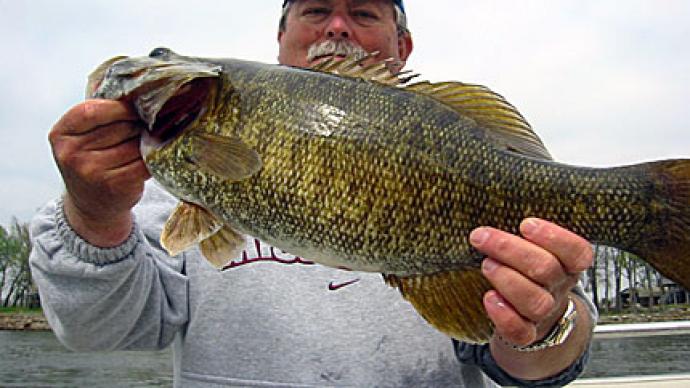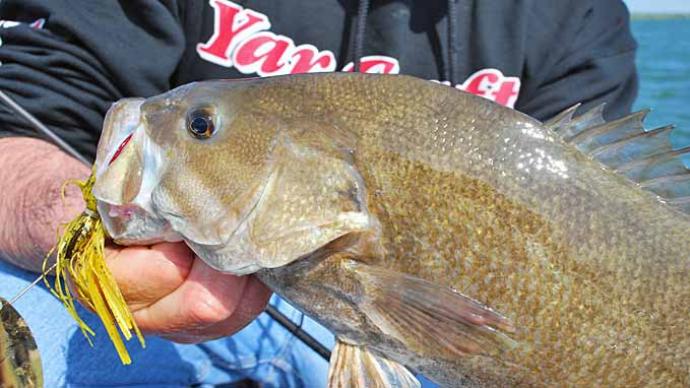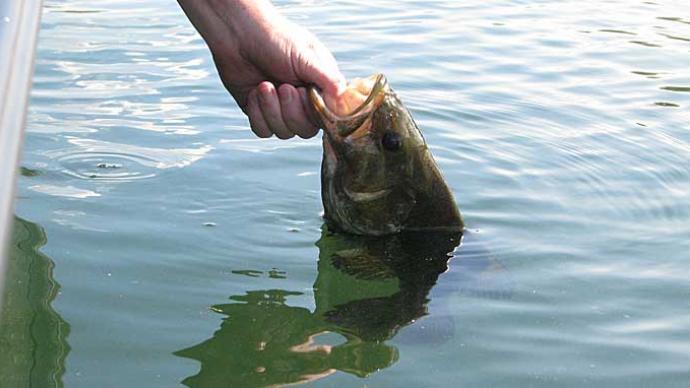Pre-Spawn

This season usually begins after the first warming trend near the end of winter and lasts until the water temperature climbs into the mid 50's. Smallmouth fishing is generally better in the early spring than largemouth fishing might be, since smallmouths tend to be more active in cold water. Begin looking for them when the water temperature is in the mid-40s. Fish the first deep water associated with a large gravel or mud flat. The smallmouths might be 20 or 30 feet deep or more on this deep drop-off, waiting for the temperature to rise slightly so they can move up and spawn. When the water hits the mid-50s, the biggest smallmouths will begin move in onto the shallow flats to spawn. The flats you should look for have a very low taper and extend a long way out into the lake, then eventually drop off deep. They will generally be found in the 10-25 foot range. Bushes, stumps and other cover are not necessary, but may add to the attraction of the flat.
Pre-Spawn Baits
- Fish jigs, grubs and split-shot worms on breaklines off flats and points for smallmouths.
- Use big crankbaits and spinnerbaits in crawdad patterns.
- 3/8 ounce frog hair jigs (has thin, living rubber), grubs, split-shot worms and bucktail jigs with a 4 inch worm trailer are good second choices. 1/8 to 1/4 ounce weights are best on the grubs, worms and bucktail jigs.
- A feather tailed grub rigged on a flat head jig head so that spirals on the fall is also a good choice.
- On river systems, a 3/8 frog hair jig in black or brown works best. Pinch off a 4 inch worm at the egg sack and thread it on as a trailer, or use a #101 Uncle Josh pork rind. To keep the pork rind in the best position, put a small piece of plastic worm on the hook shank before the pork rind.
- When fishing pre-spawn smallies in 6-15 feet of clear water key in on small almost unnoticeable points. These points, especially the ones out from small mud/gravel bays, will act as holding areas for both male and female bass on spring days when the water temp is creeping towards 50 degrees. Use topwater baits on overcast days, use a 1/32oz jighead with a #4 hook (if you can't find them use a plain hook with a small splitshot) tip the jig head with plastics, a 3" craw is tough to beat. My second choice is a 4" black or purple worm. Keep an eye on your line. On those super bright sunny days look for the shaded areas, they don't have to be very big, I have seen huge smallies hold in a 1'x1' shaded area with just their back half sticking out. Casting frequently and accurately is critical. -- Mike Sjoberg
- When searching for spawning smallies in northern shield lakes, start with the north shore of the biggest part of the lake. Channels and narrows will hold less fish than big open areas. -- Mike Sjoberg
- On a windy cold spring day try a floating Rapala in the shallow waters. It works best near an area where the water goes from calm to choppy. -- Colin Brown
Spawn
Lakes, especially the larger ones, don't warm up uniformly. Therefore, not all bass will spawn at the same time. Generally, the Northwest side of lakes and the upper areas of reservoirs warm up first. The spawning area must have direct access to the sun's rays, so look for shallow flats protected from rough water. Smallmouth will spawn on small diameter gravel next to solid objects such as wood, boulders and weeds. Smallmouths will spawn in water 3-15 feet deep. Generally speaking, the bigger the bass, the deeper the water and the earlier they will spawn. After the spawn, some smallmouths will remain shallow around flooded bushes or stumps, while others will move off to the first available deep water.
Spawn Baits
- Use minnow type baits in clear water. Rapalas, Maas Scooters, Pop-Rs, Cordell Red Fins in gold color are good choices. Use 1/2 ounce spinnerbaits in dingy water.
- Spinnerbaits work well on the first spawners of the year. You can catch BIG females this way.
- Split-shot grubs, gitzits and Texas rigged lizards in salt/pepper, blacks and purple colors work well in clearer water. Swim the lizard with a slow, steady retrieve as opposed to hopping it like a worm.
- On consecutive passes, use rattle-traps and then plastics.
- Use a 5 inch reaper when bluegill are spawning (usually during and just after bass spawn).
- Jerkbaits, jerkbaits, jerkbaits,and spider grubs -- Jeff
- During late May, early June try using a 3/8-ounce Crickhopper in small shallow creeks up to 5-6 feet deep. -- Anonymous
Post Spawn
If the beds are empty, fish points and drop-offs near flats and search for suspended bass. Post spawn bass typically are tough to catch. They spend the first two weeks after the spawn recuperating. After that, they start feeding again. Post spawn generally doesn't happen to an entire lake or at the same time due to differences in water temperature. Use a topwater bait such as a Zara Spook, even if they're 20 feet deep. Bass will also suspend under floating docks and log booms just after the spawn. Use a jerkbait, then use a jig on the second pass.
Summer
In deep lakes and reservoirs, smallmouths move offshore to deep structure as the water warms into the 70s and 80s. Here, they may be from 10 to 45 feet deep or deeper, and become very difficult to catch. However, it may be worth the effort to fish for them because a great many resident smallmouth may never see a bait that deep. Limits of large smallmouths could reward the persistent angler. Learn to fish these spots consistently well and you'll be winning tournaments.
Smallmouths often move up shallower after dark, here they feed on nocturnal forage including crawfish. Look for rocky banks with about a 45-degree slope; these generally have deep water close by. Points with a deep water access, offshore humps and channel breaks are also good. These places may or may not have any cover on them. Smallmouths seem to use deep water as "cover"--they can hide in dark, deep water just as a largemouth lies in a shallow weedbed.
Tips
- The best producing technique in the summer is split-shotting. Use small worms, reapers, grubs and gitzits in pumpkinseed and light colors for best results.
- Topwaters can be very productive, especially in low-light conditions.
- Underwater islands next to a main channel is prime smallmouth territory.
- Follow points out beyond the end, sometimes they come back up to form an underwater hump.
-
If it's 20 feet deep and comes up only 5 feet, that's a good spot. If it then drops off dramatically, park it and fish it heavily!
- In the morning, use all types of lures on this spot, they'll move around this hump all day.
- Carolina worms work better later in the day in the 20-35 foot zone.
- Use a single spin short arm spinnerbait for night fishing. Use a black nylon skirt with a black blade. Trim the skirt so it's even with the bottom of the hook and add a #11 Uncle Josh black pork frog. A pump and drop retrieve works best.
- Spider jigs are also great summer lures. Experiment with colors and sizes to find what the bass want on your lake.
- On those hot calm, summer days, Smallies will most likely be feeding on leaches. To effectively fish them, take a size 1 offset worm hook and a 4 inch power grub, cut the tail off
- Try fishing for smallies on the down-river side of channel locks. A 3 1/2" gitzit in a dark crawfish color simply drifted across the bottom is a simple and very effective method. By drifting around you'll find schools of smallies and your approach won't alarm them. Keep your hook points sharp! --Anonymous
Fall
Smallmouths move in on long points as the water moves back down into the 60s. However they will locate on the extreme ends of the points as opposed to the shallower areas, closer to deep water.
The deep sides of the point are also productive. Many fish will continue to suspend out over deep channels, but may wander shallower during the daytime and can occasionally be taken on topwater lures. Use the same lures you used in the summer, adding big crankbaits to the list.
Tips
- Try topwater! As water cools smallies move to shallower water and near the surface. Try to find a shelf or a point just offshore because it is shallow while allowing the bass
- Smallmouth tend to group more tightly in the fall. They are not as scattered as they are in the spring, especially on the Great Lakes. Once you find them, you usually have a whole school. Remember also, they generally school by size. If the fish you're catching are smaller, move on! -- Ted
- When fishing in the fall I have found that rivers are a good place to fish. Especially with a topwater Zara puppy. It is a good combination. -- Keith Haslett
Winter
Smallmouths in reservoirs often will stay at or below the 20-foot zone. The biggest smallmouths tend to stay deeper most of the time; smaller fish can be taken in shallow water, especially on overcast days. Fish sloping shale, gravel or chunk rock banks with a 45-degree angle into deep water. Deeper points will be used as holding areas. Fish the "hollows" or V-shaped area formed by narrow creeks; fish will often suspend in the middle of these places and move up onto either bank to feed. Focus on the bottom of steep drops and green weedlines. Use a vertical presentation with jigs and spoons.
Tips
- The best you can do in the winter is find the warmer water fish near power plants. The water there can be as much as 20 degrees warmer if you get close enough. -- Colin Brown
- In the winter locating the best areas to fish can be a difficult task at best. One tip is to get a topographical map and check for freshwater springs. The smallmouths love these in the winter and stack up like you wouldn't believe. Once you've found one in the 20- to 30-foot range, fish baits like 1/64-ounce marabou jigs or a Silver Buddy with a piece of flash tap on the side. -- Colin Brown



